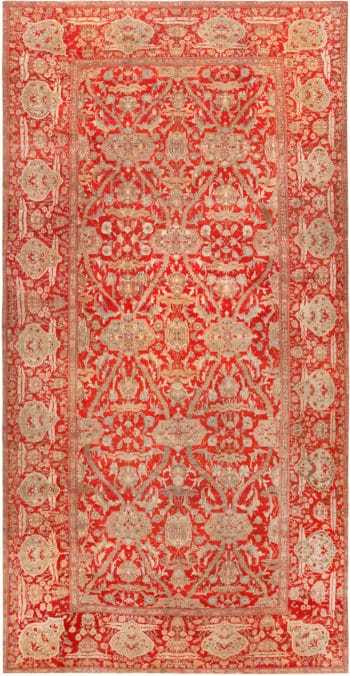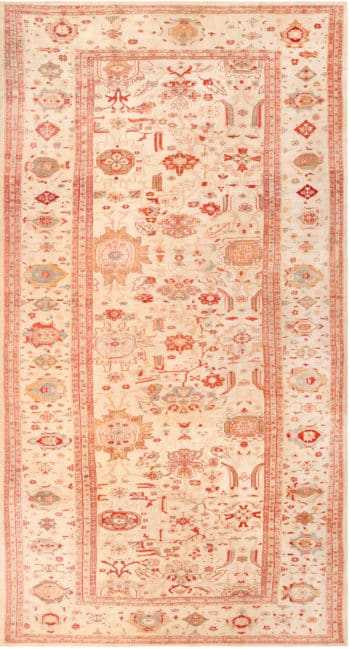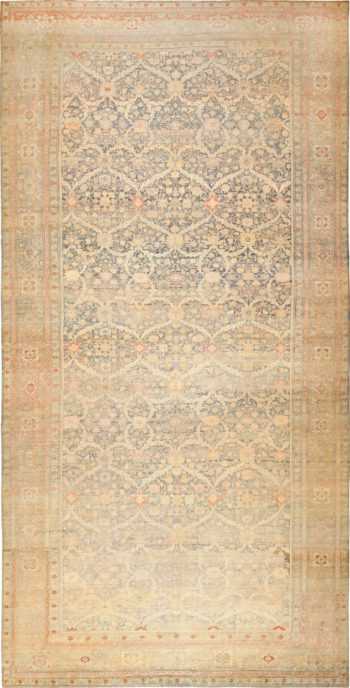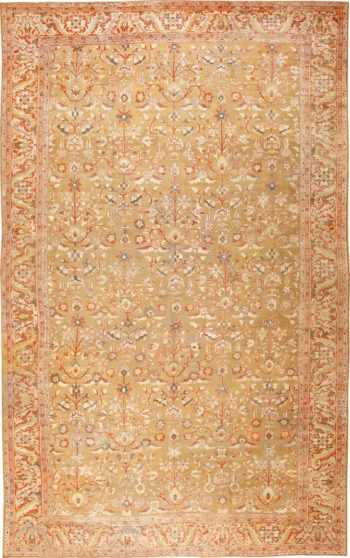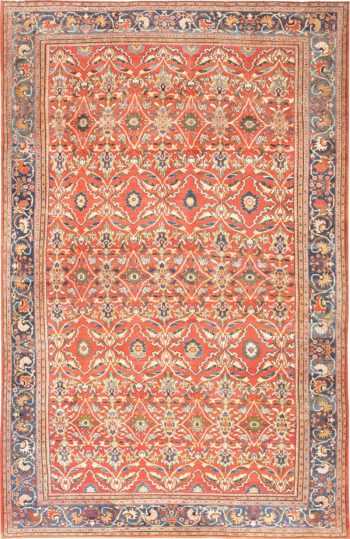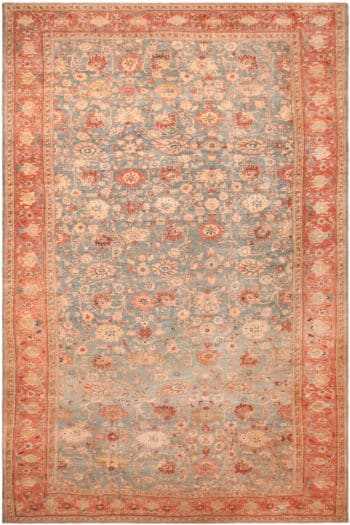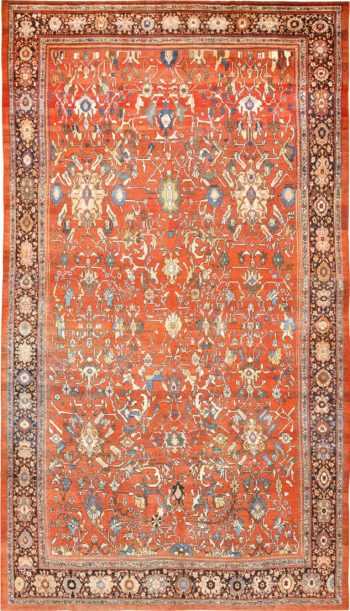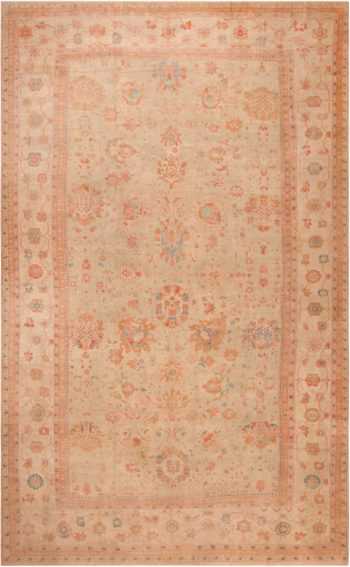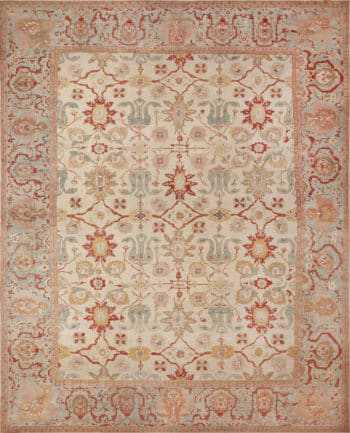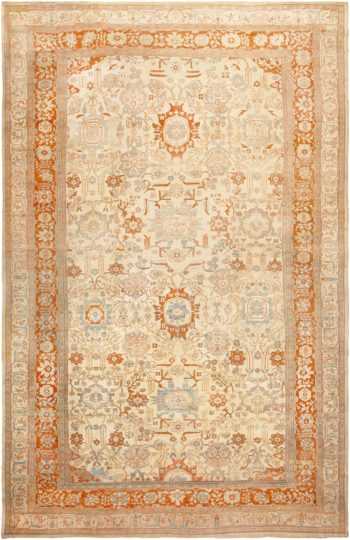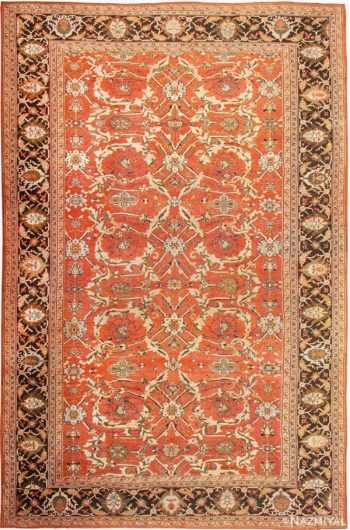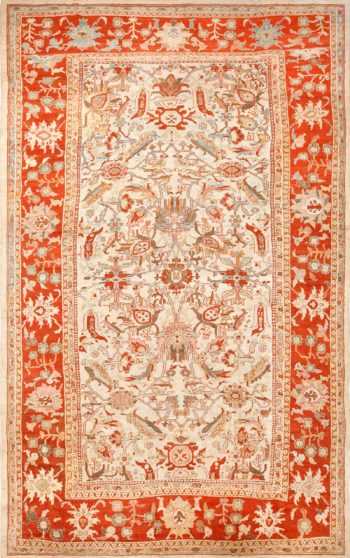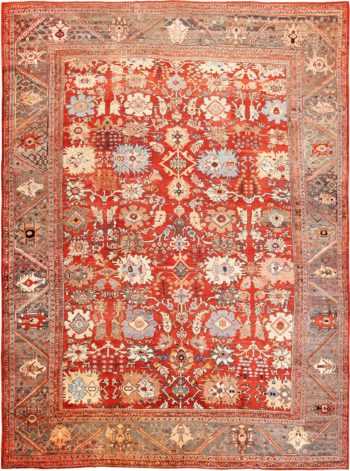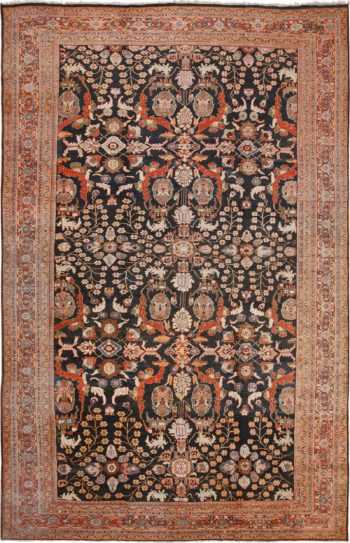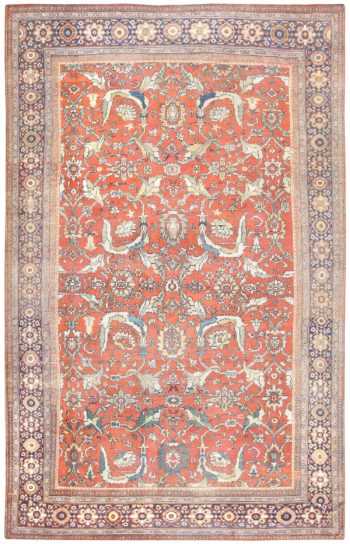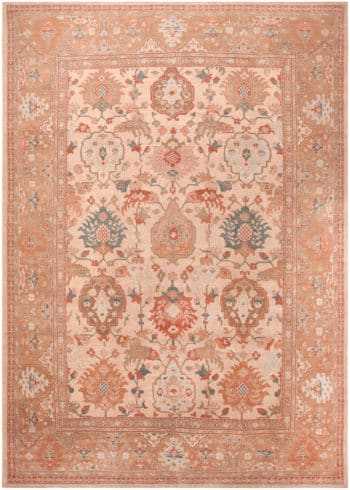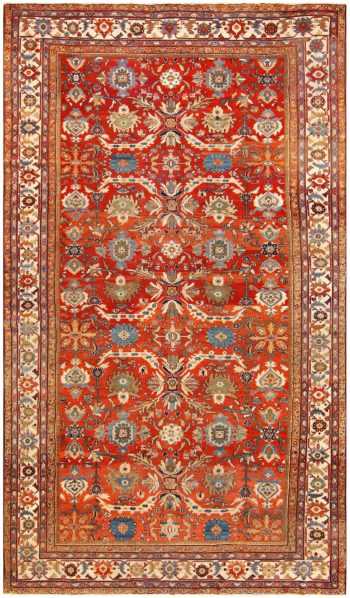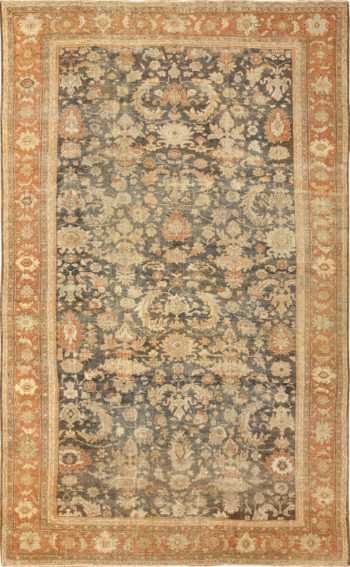Sultanabad Rugs
View our current selection of antique Persian Sultanabad Rugs below:
-
Impressive Oversized Antique Persian Ziegler Sultanabad Rug 72255
$185,000.00Size: 16 ft 3 in x 32 ft (4.95 m x 9.75 m) -
Oversized Luxurious Ivory Antique Persian Ziegler Sultanabad Rug 72353
$265,000.00Size: 14 ft x 26 ft (4.27 m x 7.92 m) -
Oversized Pale Blue Allover Design Antique Persian Sultanabad Abrash Rug 49076
$88,000.00Size: 13 ft x 25 ft (3.96 m x 7.62 m) -
Large Casual Oversized Green Antique Persian Sultanabad Rug 48944
$82,000.00Size: 15 ft x 24 ft 6 in (4.57 m x 7.47 m) -
Rust Oversize Antique Persian Sultanabad Carpet 47267
$128,000.00Size: 15 ft x 24 ft (4.57 m x 7.32 m) -
Beautiful Classic Light Blue Oversized Antique Persian Sultanabad Rug 72205
$86,000.00Size: 14 ft 9 in x 23 ft 6 in (4.5 m x 7.16 m) -
Rust Oversize Antique Persian Sultanabad Rug 50653
$68,000.00Size: 13 ft 6 in x 23 ft (4.11 m x 7.01 m) -
Oversized Decorative Allover Large Scale Design Antique Persian Sultanabad Rug 71305
$148,000.00Size: 13 ft 10 in x 22 ft 8 in (4.22 m x 6.91 m) -
Oversized Luxurious Ivory Happy Jewel Tone Large Scale Antique Persian Sultanabad Rug 72520
Size: 18 ft 2 in x 22 ft 6 in (5.54 m x 6.86 m) -
Magnificent Oversized Ivory Background Antique Persian Ziegler Sultanabad Rug 46452
Size: 14 ft 5 in x 22 ft 3 in (4.39 m x 6.78 m) -
Rustic Oversized Decorative Antique Luxurious Persian Sultanabad Rug 71514
$365,000.00Size: 16 ft 10 in x 21 ft 10 in (5.13 m x 6.65 m) -
Large Oversized Antique Rust Color Persian Sultanabad Area Rug 42746
Size: 14 ft 5 in x 21 ft 9 in (4.39 m x 6.63 m) -
Earth Tone Oversized Antique Persian Sultanabad Rug 44653
$76,000.00Size: 12 ft x 21 ft 8 in (3.66 m x 6.6 m) -
Grey Background Allover Tribal Design Oversized Rustic Antique Persian Sultanabad Rug 71818
$125,000.00Size: 11 ft 10 in x 21 ft 4 in (3.61 m x 6.5 m) -
Beautiful Large Ivory Persian Antique Ziegler Sultanabad Rug 49322
$149,000.00Size: 12 ft 4 in x 20 ft (3.76 m x 6.1 m) -
Large Rustic Antique Persian Sultanabad Carpet 70279
$125,000.00Size: 14 ft 4 in x 19 ft 4 in (4.37 m x 5.89 m) -
Ivory Antique Persian Sultanabad Runner Rug 50412
Size: 5 ft x 19 ft 3 in (1.52 m x 5.87 m) -
Large Allover Design Charcoal Color Antique Persian Sultanabad Rug 70292
$49,000.00Size: 12 ft x 19 ft 2 in (3.66 m x 5.84 m) -
Large Size Antique Rustic Persian Sultanabad Area Rug 50126
$48,000.00Size: 11 ft 10 in x 19 ft (3.61 m x 5.79 m) -
Large Ivory background Antique Persian Sultanabad Carpet 70940
$165,000.00Size: 13 ft 4 in x 18 ft 9 in (4.06 m x 5.71 m) -
Large Ivory Allover Design Antique Persian Sultanabad Rug 71756
$76,000.00Size: 10 ft 6 in x 17 ft 10 in (3.2 m x 5.44 m) -
Ivory Large Scale Allover Design Modern Persian Sultanabad Rug 72160
$12,950.00Size: 12 ft 6 in x 17 ft 6 in (3.81 m x 5.33 m) -
Antique Tribal Rustic Red Large Scale Allover Design Persian Sultanabad Carpet 48563
Size: 10 ft x 17 ft 5 in (3.05 m x 5.31 m) -
Large Decorative Gray Color Allover Design Antique Persian Sultanabad Rug 49366
$39,000.00Size: 10 ft x 17 ft 3 in (3.05 m x 5.26 m)
Learn More About Persian Antique Sultanabad Rugs
Antique Sultanabad Rugs The city of Sultanabad (which is now known as Arak) was founded, in the early 1800’s, as a center for commercial rug production in Iran. During the late 19th century, the firm of Hotz and Son and Ziegler and Co. established a manufactory in Arak / Sultanabad whose sole objective was to produce rugs to meet the Western demands. They even brought over Western designers to conform to the Western tastes of the time. This was the first instance of a hands-on Western influence in the industry (which until this point was sheltered from western insights). Many of the Persian Sultanabad rugs that were woven by Ziegler and Co., featured more updated colors as well as larger scale all over patters which some in the art history world attribute to being the initial formation of the Arts and Crafts movement.
The term “Sultanabad rugs” (as opposed to “Mahal carpets“) is mostly a term that is used to reference the “better” rugs that were woven in Arak.
While both the Sarouk Farahan and Sultanabad rugs were woven in the same general geographic area, the two are quite different. While the Sultanabad rugs do share some of the Persian design repertoire, they tend to have a larger, more supple weave (and accordingly exhibit a bolder, more large scale design).
The design of Sultanabads tends to be more closely associated to those of Heriz or Serapi. That said, the line work of Sultanabads are more curve-linear and classical while they do maintain a more casual and tribal feel. Sultanbad rugs will often have more warm color palettes which also tend to resemble those of the earliest Sarouk Farahan Persian carpets.
The rugs of Sultanabad are extremely desirable in the modern marketplace. The popularity of Sultanabad rugs go back to the mid-19th century. These carpets were designed and produced primarily for export to European consumers, as was the case with the Ziegler firm.
Designers in Sultanabad tinkered with the more traditional Persian color palettes. Though rooted in history, these weavers reinvented the old Persian designs and adapted them to suit the more Western tastes.
Although the rugs of Sultanabad were not always considered purely Persian, they have become classics in their own right. Carpets inspired by the designs of Sultanabad are still manufactured for Western consumers today. Antique pieces from the area sell for top-dollar at auction.
Carpets from Sultanabad feature a diverse selection of colors that defy classification. Traditional color palettes found on carpets from Sultanabad can include subtle neutrals, vibrant reds and clear blues that create a regal Western appearance. Unique color combinations, such as tourmaline pink paired with oxidized green, are also found on rugs from Sultanabad, which highlights their tendency to reinvent the traditional.
The diverse style of Persian Sultanabad rugs gives buyers the opportunity to choose between light and airy neutrals or richly colored carpets that provide a somber, grounded feeling. In the modern home environment, antique Sultanabad rugs have the ability to unite the old with the new.
Antique Sultanabad Rugs History and Collection
Sultanabad rugs are one of many famous carpet types originating in the Arak area of central Iran. These Western-influenced carpets are very different from the Sarouk and Farahan carpets produced nearby.
Sultanabad was built on the remains of earlier settlements with the majority of construction efforts occurring between the late 1700’s and mid-1800’s.
The county quickly gained a reputation for its arts, crafts and cultural industries, including ceramics, metalworking and rug production, including the development of a unique antique rug style. Historical documents suggest the area played an important role in the commercialization of the rug industry as early as the 17th century.
The region’s reputation for producing high-quality rugs and carpets led to a fateful decision by the foreign export firm Ziegler and Co., who decided to establish workshops in the Sultanabad area sometime around 1883. This move gave Ziegler more control over their product and overseas profits.
The firm’s innovative marketing and product development strategies led to partnerships with designers from the prestigious Liberty of London department store as well as B. Altman and Company of New York. These designers revamped Safavid patterns from the 1500 and 1600’s to suit Western tastes. Their formula centered on adapting and redrawing these elegant designs in a new selection of colors.
Ziegler Sultanabad Rugs
The new style of Sultanabad carpets was met with great enthusiasm by consumers at home. The Guinness family of brewing fame was one of the first high-profile consumers to decorate their British estate with elegant Sultanabad carpets. The popularity of the Sultanabad style continued through the early 20th century. The Ziegler firm was also instrumental in expanding the size of Persian carpets to suit the needs of consumers and fit emerging trends associated with the Arts and Crafts style.
Ziegler & Co., a Swiss import company based in England, identified the high demand in the West for Persian carpets and set up workshops in the Sultanabad region in the late 1870’s to produce carpets that would appeal to Western tastes.
Designers from major department stores including Liberty of London dictated color palettes and rug patterns. Specially dyed wool’s and oversized looms were provided to weavers to produce these custom-made carpets.
Antique Ziegler Sultanabad carpets feature both all-over floral motifs and central medallion patterns in soft colors and a higher pile. Designs are symmetrical and balanced, creating a feeling of spaciousness in the field with proportionally pleasing borders.
Ziegler’s were produced until the 1920’s, when the world-wide economic depression affected consumer markets. In order to rescue the depressed market and continue employment for weavers, the Iran Carpet Company stepped in to oversee production in the area.
History of Sultanabad Rugs and Carpets from Persia
Among the various types of late nineteenth-century Persian room-size rugs that grew out of the grand tradition of classical era Safavid carpets, Sultanabads tend to stand apart for a number of reasons. Safavid Persian carpets were often monumental in size, but their designs tended to be finely detailed with countless curves, and the component motifs were relatively small in comparison to the size of the field.
When one looks at nineteenth century Persian carpets that exemplify the continuation of this tradition such as Kashans, Tabrizes, or Kermans, they display a striking fidelity to this sense of finesse and small-scaled ornamental detail, no matter how large they may be.
Sultanabads too derive from the same classical Persian repertory of arabesque floral designs. But in contrast to these other types, Sultanabads are distinguished by a monumental scale and grandeur, not only in their actual size, but especially in terms of the decorative elements themselves. The various palmettes and stylized leaves or flowers and the main lines of the design are very much in keeping with the size of the field.
And this is true not only in example with large central medallion designs, but even in examples with allover repeat patterns, where the basic element that is repeated is relatively large in proportion to the field, with less actual repetitions. The result is that the designs on Sultanabads always seem to be writ large, so to speak. They have an imposing, almost palatial quality, whether they are twelve feet long or twenty.
The reasons for this are not entirely clear, but they may have to do with the origins of their production. Sultanabads are essentially a particular type or grade of Mahal. Indeed the term Sultanabad is essentially used to distinguish the oldest and highest quality Mahal carpets, which were produced in the Arak region in the late nineteenth century. Some Sultanabads are also known as Zieglers, named for an Austrian firm that supervised their production locally in Iran for export to the West.
Sultanabad rugs were made in the same area at the same time as the earliest Farahans and Sarouks, but they are very different. Ultimately, they share a common classical Persian repertory of floral motives, whether they utilize medallion patterns or overall designs of vine scrolls and palmettes. But the early Farahans and Sarouks have a smaller scale to their designs, like Kirmans, and Kashans, rather than the grand scale of Mahals or Sultanabads.
Some rug experts are of the opinion that the term Mahal actually had no regional sense or meaning, but that instead it was coined to distinguish Arak carpets with a bolder, coarser weave and, concomitantly, a bolder, larger design scale. But this still begs the question as to why they were made this way, as opposed to the Farahans and Sarouks from the Arak region.
Certainly, the coarser or larger weave is not simply an economic shortcut. The Ziegler firm would never have supervised the production of pieces for the European market that were considered to be inferior. And ultimately larger weave is appropriate to large scale design.
It is perhaps possible that the grand scale was meant to attract European or Western clients who were specifically interested in acquiring carpets with an impressive, palatial look. But the weaving technique must also have to do with the background and tradition of the weavers themselves, and here a comparison to some other Persian rug types may be instructive.
The only other room sized rugs with such grand scale produced in late nineteenth century Iran were Heriz or Serapi and Bakshaish carpets. In fact the drawing of Sultanabads resembles that of Herizes and Bakshaishes somewhat in its graphic and monumental character, although it is always much more curve-linear and classical. The origins of these latter two types are unclear, but it seems that their production began as an attempt of village weavers working in a Northwest Persian or Caucasian tradition to produce large scale carpets with classically derived designs for the Western market.
This explains why Herizes and Bakshaishes have such tribal quality or taste for large-scale geometric stylization. It could just be that weavers of this kind were also employed in Arak to produce the first Mahals or Sultanabads. In the case of Heriz and Bakshaish carpets though, the angular and graphic sensibilities of the village weavers still dominated the ultimate effect of the rug, whereas the Sultanabads, managed to retain more of suave urban sophistication of the classical Oriental carpets. In this regard we may be looking at the controlling influence of the organizers of the Sultanabad production, possibly even the Ziegler firm itself.
In terms of color, Sultanabad or Mahal carpets also often have the same rich, warm palette like that of Farahans and the earliest Sarouks, but this is hardly surprising. The Sultanabad weavers would have been supplied by the same local wool and dyeing industry as the Farahans and Sarouks made at the same time in the Arak area.
Yet the different sensibility in scale and weave texture that Sultanabads display can only be explained in terms of their production by a different group of weavers than those who made the Farahans and Sarouks.
Who they were and where they came from, and the particular circumstances that brought them into the Arak area, we may never know. But they have left their distinctive stamp on the classical designs they were induced to produce, and today we can enjoy the spirit of bold grandeur that they so lovingly put into their work.
On the surface, Sultanabad carpets feature large-scale designs and broad arabesques that are easily interpreted. However, the differences also include variations on traditional dyeing techniques that Ziegler attempted to patent several times without success.
Today, antique Sultanabad carpets continue to attract buyers around the world who prefer their spacious designs and distinct color palettes.
Beautiful Antique Persian Sultanabad Rugs
Here at Nazmiyal, there is nothing that we know more about or love quite like antique rugs. An antique rug really draws focus to a room and adds a sense of history to your living space.
So, whether you’re decking out that old-world meets modern-day chic apartment or going for that full-blown antique roadshow look, an antique rug will send your apartment straight towards the fashion highway of home decor.
This week’s rug feature is all about the Sultanabad rug. You may be asking yourself, “Oh, but Philip, what are antique Persian Sultanabad rugs?” Lucky for you, I’m about to give you a brief little history lesson: These puppies were popularized in the 18th and 19th century when a Western importing company by the name of Ziegler and Co.
Decided to cash in this high trade artisanal craft. Ziegler was one of the first importers to incorporate Western design into the antique Persian motifs of the Orient rug industry in order to please a booming number of Western buyers in the late 19th century.
The antique Persian Sultanabad rugs soon came to be known for their larger scale proportions in terms of weave and size, their nouveau (for the time) Western color palettes, and their ornamental and grandiose design.
Today, these rugs are one of the most sought-after pieces of home decor for they truly are antique masterpieces that set apart the junior novice collector from the antique rug extraordinaire. Their beautiful design and bold color palettes are sure to stand out and grab your guests’ attention.
Not to mention, the countless times you’ll be caught staring at your floor gawking at your Sultanabad beauty.
Antique Sultanabad Rugs from Iran
The town of Sultanabad, modern-day Arak, has been an important center for carpet production since the 1800’s. Arak, the capital of the province Markazi, is located in western Iran on the eastern side of the Zagros Mountains, approximately 1800 meters above sea level.
The term “Sultanabad” refers to not only the town, but a region that includes outlying areas engaged in village carpet weaving. Antique carpet production in Sultanabad has flourished and ebbed in direct relation to world historic events including wars, Western influence in Asia and world demand for imported textile goods.
All in all, antique Sultanabad rugs and carpets represent an important and unique antique rug style.
The common elements shared within these different oriental and Persian carpet styles define a regional tradition that is distinct from those in adjacent areas. The Sultanabad rugs use the Persian or asymmetrical knot, generally have a cotton foundation (warp and weft) with woolen pile and use several conventions of floral motifs and colors.
Knot count usually falls within the 70 to 150 knots per square inch (kpsi) range, although some are higher, at 300 kpsi or more.
These Iranian rugs are made in various sizes; a large format to accommodate rooms in Western houses became typical for Sultanabad carpets.
Decorating a Home with a Beautiful Antique Sultanabad Rug
Decorating an interior with antique rugs offers designers a myriad of exciting opportunities. Depending on the style of the antique rug being placed in a room, a designer will have a range of options.
For example, when decorating with antique Sultanabad rugs from Persia, a designer may choose a bold and expressive Sultanabad to put an exclamation mark on an otherwise more understated interior, or a designer may choose a more subdued antique Sultanabad rug, placing it alongside furniture with a similar color palette, thus creating a sense of uniformity.
The Sultanabad rug featured in the photo above is a wonderful example of the versatility of Sultanabad rugs. A fetching, traditionally Persian piece can be the focal point of the room, even from a distance. The beauty inherent to the finest Sultanabad rugs makes them ideal for adding class an sophistication to any space.

